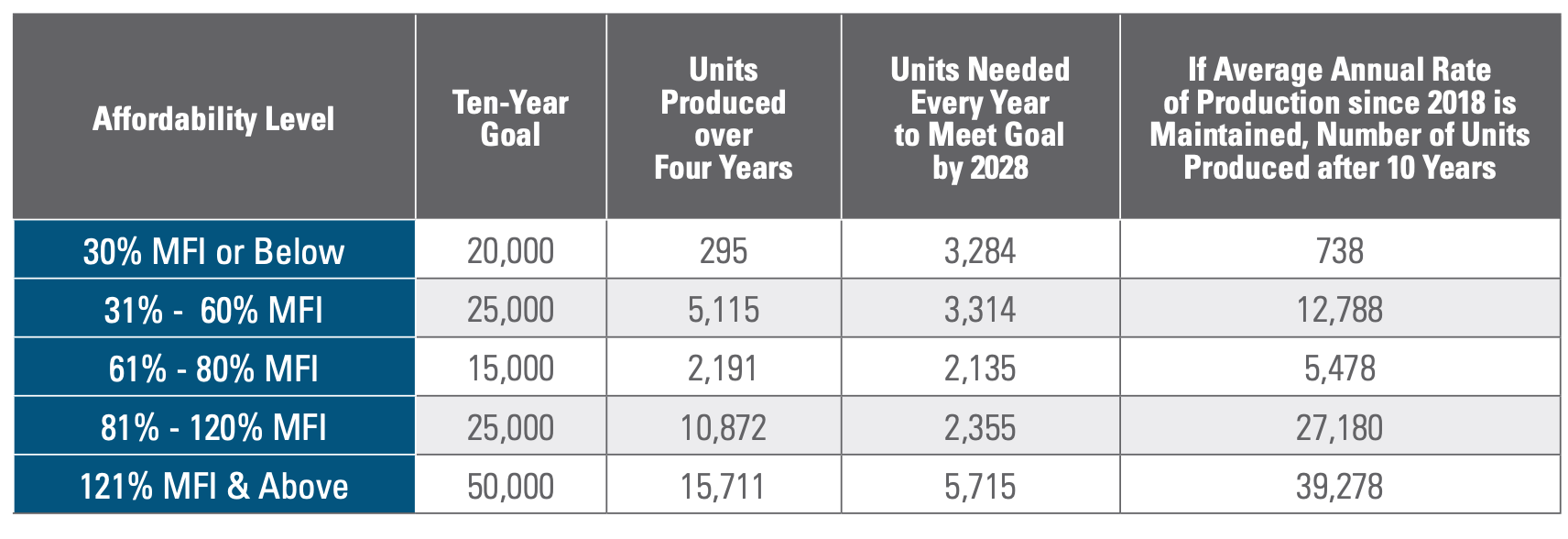City falls further behind on affordable housing goals
Thursday, September 22, 2022 by
Jonathan Lee The city continues to fall behind on its affordable housing goals, according to a report from nonprofit HousingWorks Austin.
In 2021, nine out of 10 Council districts failed to achieve district-based affordable housing production goals, and seven out of 10 did not even meet half of their goals. Only District 4, which has the lowest annual target of all the districts, exceeded its goal.
The numbers come from the Strategic Housing Blueprint Scorecard, an annual update on progress toward producing 135,000 new housing units, 60,000 of those affordable to those making below 80 percent of the median family income, within 10 years. City Council adopted the plan in 2017.
The chart below shows the numbers for each district in 2021:

Nora Linares-Moeller, executive director of HousingWorks Austin, said that the failure to reach the goals last year was due to a “perfect storm” of forces.
For one, land values have increased as demand for homes in Austin has soared, making affordable units more expensive to subsidize. On the supply side of things, high construction costs, a shortage of construction workers, and inflation and supply chain issues have made it hard to keep up with demand.
Linares-Moeller also pointed to an outdated Land Development Code and neighborhood opposition to affordable housing as contributing factors.
Even as the city failed on key metrics in 2021, it succeeded in other areas. The city preserved 1,550 existing units already affordable at market prices, well above the annual goal of 1,000 units. It also surpassed a goal of locating new affordable housing units near growth areas identified in Imagine Austin, the city’s comprehensive plan.
Cumulative numbers also show lagging progress
The cumulative data, which go back to 2018, show that all districts are behind where the Strategic Housing Blueprint says they should be by now. Districts 6, 8 and 10 are especially lagging.

The district-by-district breakdown shows an uneven distribution across the city. Most affordable units that have been built or are in the pipeline are located in East Austin.
“A myriad of factors make it harder to build affordable housing west of I-35,” said Council Member Natasha Harper-Madison, who represents District 1, “including higher land values, larger areas of single-family zoning, deed restrictions that block multifamily buildings, and more people with the time and wherewithal to organize and resist projects in their backyards.”
There are also disparities between units produced at different affordability levels. While housing for middle and upper incomes is closest to hitting the targets, homes affordable to those at the bottom of the income spectrum are lagging the most. Only 295 of units affordable to those making 30 percent have been built so far – just 1.5 percent of the 10-year goal – in large part because of the cost to subsidize deeply affordable units. Last year, 87 units affordable at 30 percent MFI were built.

Closing the gap
More than 7,000 affordable units are currently under construction, with more in the pipeline. While those numbers are encouraging, Linares-Moeller said, the city must do more to have a chance at achieving the blueprint’s goals by 2028.
“As housing advocates, we always propose that the Council talk more about the Land Development Code,” she said, pointing to upcoming discussions about changing compatibility, which limits the height of buildings within 540 feet of single-family homes.
Harper-Madison also suggested addressing compatibility as well as parking requirements and the development review process.
Council Member Kathie Tovo said that building more housing on publicly owned land, as identified in the Strategic Housing Blueprint, could lead to more deeply affordable housing.
Linares-Moeller said it’s critical voters approve a $350 million affordable housing bond on the November ballot: “If the bond package in November doesn’t pass, there will not be very much subsidized money to produce these units.”
She also hoped November brings a renewed push for policies to address the housing crisis. “We’re hoping that that gives us a whole new group of people that are really in tune to the affordability issue and really want to see more things happen,” she said. In addition to the mayoral race, seats in districts 1, 3, 5, 8 and 9 are up for grabs.
In the meantime, as progress on affordable housing construction continues to lag, lower-income people will continue to suffer, Linares-Moeller said.
“If we don’t have the affordability on the ground for them, then we’re going to lose them. And that’s just going to hurt our schools, it’s going to hurt our restaurants or hotels, all of the people that depend on those kinds of workers,” she said.
Photo made available through a Creative Commons license.
The Austin Monitor’s work is made possible by donations from the community. Though our reporting covers donors from time to time, we are careful to keep business and editorial efforts separate while maintaining transparency. A complete list of donors is available here, and our code of ethics is explained here.
You're a community leader
And we’re honored you look to us for serious, in-depth news. You know a strong community needs local and dedicated watchdog reporting. We’re here for you and that won’t change. Now will you take the powerful next step and support our nonprofit news organization?













